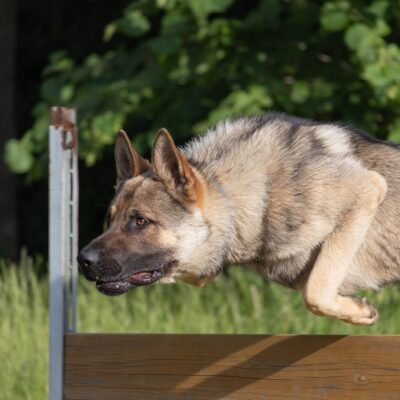On average, dogs can learn around 165 words. Some of the more intelligent breeds are said to be able to learn up to 250 words, and the world’s most intelligent dog knew over 1000 words.
Busy? Get Your Hands Paws On The Answers Quickly…
- How To Teach A Dog New Words
- Do Dogs Understand When You Talk To Them?
- Do Dogs Know Their Name?
- Top 15 Basic Tricks and Commands To Teach Your Dog
- FAQs
HOW TO TEACH A DOG NEW WORDS
The simplest way to teach a dog a new command is by association, repetition, and reward. Training should be positive, short, and fun. We recommend using play and treats as rewards for training. As the command becomes more and more familiar, these can be phased out gradually.
Teaching your dog a trick (e.g., sit, stand, up, stay, wait, paw, down, etc.):
- Start by holding a treat in front of your dog, with your hand closed.
- The dog will then do everything it can to retrieve the treat.
- Once it does the trick, you are trying to teach (e.g., sit his butt on the ground), use the word (e.g., sit), and reward with the treat.
- Repeat this process several times until your dog is familiar with the trick.
Teaching your dog a name (e.g., blue ball, green rope, Susan, etc.):
- Start with one toy; keep it simple and easy to understand.
- Show the dog the toy and name it (e.g., blue ball).
- Play with the toy together, repeat the name (e.g., Get the blue ball, fetch the blue ball, catch the blue ball) and praise every time the dog responds to the name.
- When the dog is repeatedly getting the toy, move the toy further away or into another room.
- Once your dog can retrieve the toy and distinguish it from others, introduce another.
DO DOGS UNDERSTAND WHEN YOU TALK TO THEM?
Many argue that dogs respond to the tone, eye movement, and body language used as opposed to the word. Whether a dog actually understands the meaning or associates it with a reward is up for debate.
For example, using the word ‘walkies,’ your dog may leap up and go straight to where the lead is kept in excitement. Many argue this is not because your dog thinks “My lead is kept in the top right drawer by the front door” but because of repetition and reward. Every time you say walkies, you get the lead from the same place, and the dog is rewarded with a walk. So rather than understanding the meaning of the word, it understands your repeated tone and movement.
However, cases like Rico and his ability to fast-map astounded the scientific world. “Fast-mapping is the term used for the hypothesized mental process whereby a new concept is learned based only on minimal exposure to a given unit of information.” (link) Rico was able to learn the name of over 200 items and identify them by name. Rico was also able to find objects based on exclusion learning. This means he was able to learn and identify the name of a new object, as it was amongst objects he already knew the names of.
A study was conducted on a dog’s ability to recognize emotions in both their species and humans. The dogs were shown pictures of both happy and angry people and dogs, along with happy and angry audio. The result showed that the dogs had a clear preference for the emotions which matched. Showing that dogs were able to match vocal and physical emotional queues (link).
Whether it’s your voice, the movement you make, or the word you say, there is no denying our dogs have an incredible ability to understand us.
We’re not sure. When a dog hears ‘Buddy, come’ do they understand that the ‘Buddy’ part refers to them and is their name? Or is it just that they have learned the tone of voice, the reaching for the lead, or the treat, and then when they do respond, they will receive a reward?
Whether a dog understands they have a name is up for debate. However, there are many ways to help your dog to listen, understand, and respond better to their name.
- Choose a name that is two syllables, and that is not similar to any command you plan on teaching your dog (e.g., instructing Kate to wait).
- Use your dog’s name positively. They are then more likely to respond.
- Don’t use your dog’s name when you are not talking to him. Otherwise, they will be confused as to when to respond.
- Train your dog to respond to their names. Do this by saying your dog’s name, when they respond (make eye contact or look at you) reward with a treat. Start by doing this with your dog near, then increase the distance gradually.
TOP 15 BASIC TRICKS AND COMMANDS TO TEACH YOUR DOG
Sit – Put your bottom on the ground
Stand – Get up off of the ground
Wait – Wait where you are and don’t move until I call you
Stay – Wait where you are and don’t move until I come back
Paw – Give me your paw
Down – Lay down
Come – Come to me
Heel – Walk on a loose leash next to me
On Your Bed – Get on/in your bed/in your crate
Speak – Bark now
Quiet – Stop barking
Back – Walk backward out of here
Out – Drop whatever you have in your mouth
Leave it – Do not pick that up
Settle – Calm down, lay down, and relax
How many words does the smartest dog know?
Chaser, the border collie, knew upwards of 1000 words.
How many words can an average dog learn?
Approximately 165 words.
How many words can a Labrador retriever learn?
Labradors are in the top 10 of bright dog breeds, and therefore can probably learn up to 200+.
What is the dumbest dog?
Afghan hounds make the last place on many lists of dumbest dogs. However, the rankings are decided on ease of training, the ability to learn new tricks, and listen. Hounds are nose led and therefore spend most of their time distracted with their nose to the ground. So they might not necessarily be ‘dumb’ but just more stubborn, or interested in doing what they were bred for.
What is the best age to teach your dog tricks?
Start as soon as you get your dog, whether that’s eight weeks or eight years. Start slow and for short amounts of time. Keep the training fun and enjoyable for the dog by using plenty of rewards, play, and praise.
How long does it take to train a dog basic commands?
It depends on both the dog and the owner. Some dogs are incredibly quick to pick up tricks, while others take a bit longer. Be patient and consistent. Keep training short and exciting.
What are the smartest dog breeds?
According to ‘The Intelligence of Dogs‘ by Stanley Coren, border collies are considered the smartest breed, along with German Shepards, Poodles, Dobermans, Golden Retrievers, and Labradors.
Looking for more pawsome posts? Check these out…
Can Dogs Eat Lettuce?
How To Make A Snuffle Mat
When Do Puppies Lose Their Teeth?
Can Dogs Eat Broccoli?
Can Dogs Eat Watermelon?
Disclaimer: Each dog is different, and every circumstance is different. All efforts have been made to provide accurate information. However, it is not provided by a qualified Veterinarian, Veterinarian Surgeon, or Behaviorist. The information provided is purely educational. The information should not be used as an alternative or substitute for medical care. If you have any health or medical concerns, contact a qualified Veterinary Surgeon or Veterinarian immediately.











No Comment! Be the first one.